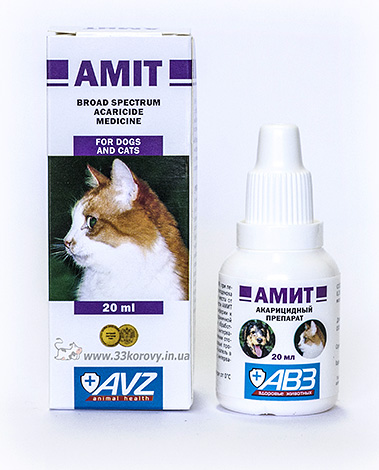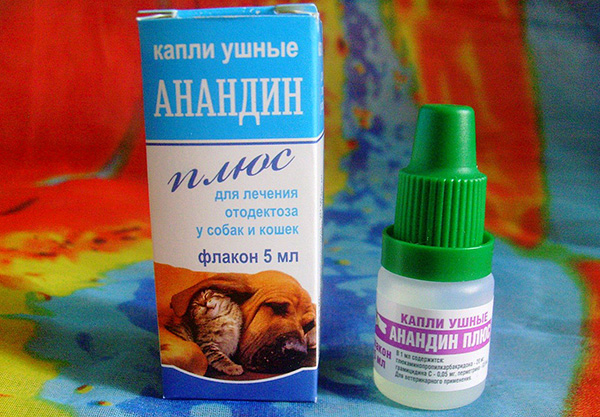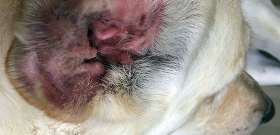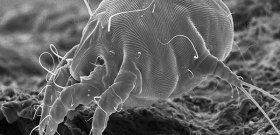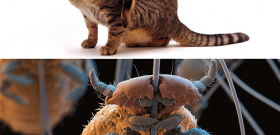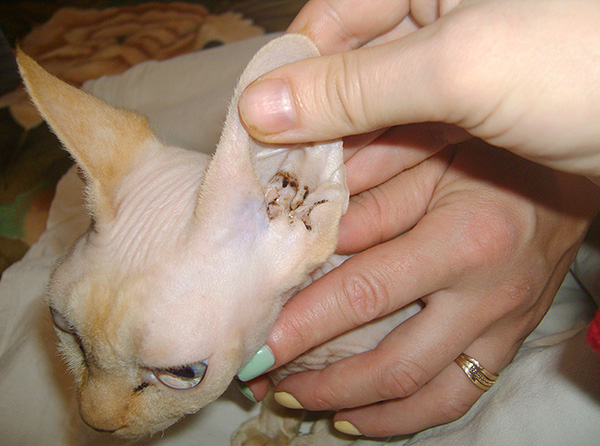
Almost all experienced cat owners have ever encountered such an unpleasant disease in a pet as otodectosis - in other words, ear scabies, which is caused by parasitism in the ears of the microscopic parasitiform mite Otodectes cynotis. This dangerous parasite develops in the external auditory canal of various carnivores (cats, dogs, foxes, ferrets, arctic foxes).
In dogs, as in fur-bearing animals, otodectosis is recorded sporadically: the frequency of damage depends on the sanitary conditions of keeping or the state of the population in wild communities. Cats become infected much more often, their disease often proceeds with complications and can be chronic.
On a note
It is also important to take into account the fact that the symptoms of ear scabies can appear periodically, and during periods of rest the cat will look as if healthy, but at the same time it will be an active spreader of the parasite, which is very dangerous, since the tick is quickly transmitted to other animals. It is precisely because of the frequent manifestation of the latent period that it is more difficult to detect ear mites in cats than in dogs.
Usually, pet owners notice symptoms at the stage of severe infection, when the disease is already seriously affecting the health of the pet. If treatment is not started in a timely manner, then complications may arise in the form of purulent otitis media, which in the future can lead to meningitis and death of the animal.
For people, the ear mite also poses a certain threat, since the owner can become infected from a sick pet. In the world, cases of ear mite parasitism on humans have been registered and described.
Nutrition and reproduction of ear mites
Otodect mites - very small parasitesreaching 0.8 mm in length. Their body is oval, slightly elongated, yellow or brownish in color.
The photo below shows how such mites look under a microscope:

The life cycle consists of the following stages:
- egg;
- larva;
- nymph;
- imago (adult).
The full development of an ear mite under favorable conditions can take place in 10 days. In fact, when a cat is heavily infested, hundreds of new parasites appear in her ears every week. Parasitization of each individual lasts about a month, after which the mites die, leaving the host with numerous offspring.
Imagoes have 4 pairs of legs, and in females the last pair is reduced - see the photo below:
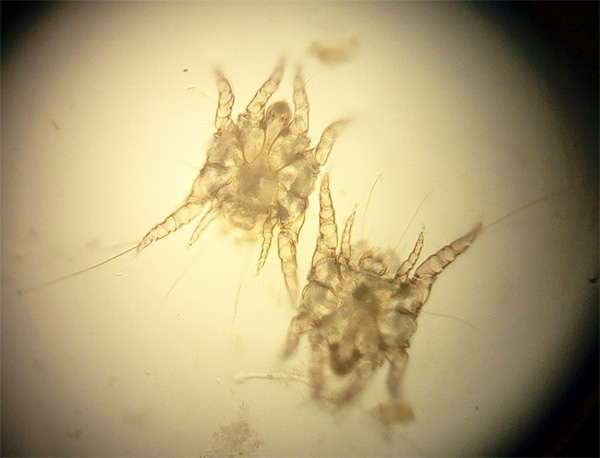
On a note
The limbs of the tick are equipped with powerful hooks and suction cups, so the parasite is very firmly fixed in the ear, and it is almost impossible to shake it out while shaking the head. Animals instinctively shake their heads and hit their ears with their paws, but this only leads to hematomas and early complications.
Male ear mites mate with prepubescent females right in the host's ear canal. The female subsequently lays whitish oblong eggs - in large clusters on the inside of the ear canal.
After some time, larvae hatch from them, which immediately begin to feed. After they molt and turn into nymphs.
At all stages of the life cycle (except for the egg), the parasite feeds intensively.Ticks cut through the thin skin of the ear canal with their mouthparts and consume the secreted blood and ichor. In addition, parasites secrete saliva, which prevents blood clotting and healing of wounds.
After some time, literally the entire auditory canal is filled with crusts of dead epidermal cells, dried exudate and secretions of ear mites. This mass, which looks like brown lumps, is abundantly excreted from the ears of the animal in case of severe infection.
This is what the discharge from the ears of a cat with otodectosis looks like:

This symptom indicates that the disease has reached its peak, and treatment should be started immediately.
However, it is highly desirable to be able to detect a tick even before intense damage to the ears. To do this, it is necessary to carry out preventive examinations, the methodology of which should be considered in more detail ...
Inspection of the cat for the presence of the parasite
If the cat regularly walks on the street and / or comes into contact with other animals, then it is necessary to conduct a preventive examination. The frequency of such inspections can vary, and depends on how often the pet leaves the premises. In general, experts recommend checking at least 2 times a month.
At home, it is quite easy to carry out such an examination, as well as to clean the ears of a cat for preventive purposes. Initially, you need to place the animal in a place convenient for such manipulations. At home, a high table, standing in a well-lit place, is suitable.
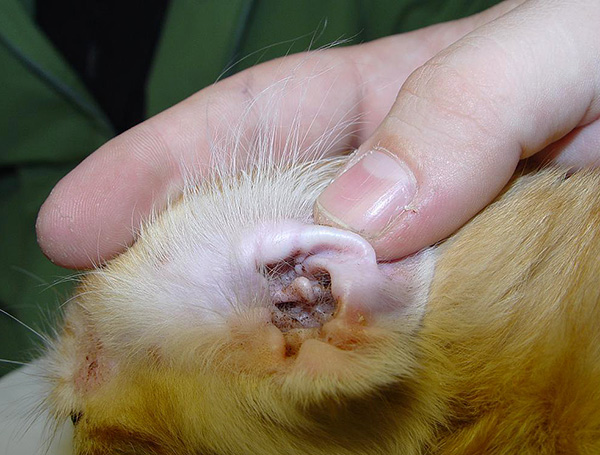
If the animal behaves calmly, then you can leave it in any position that is comfortable for it. If the cat is nervous, then it is better to “fix” it. For this purpose, it is advisable to use a towel or a soft blanket.It is necessary to tightly wrap the pet in a cloth, leaving only the head free: the limbs should be well fixed, but the animal should not experience pain.
After preliminary preparations, the actual inspection is carried out:
- With one hand, the cat's head tilts slightly - so that a sufficient amount of light falls on the examined ear;
- With the other hand, it is necessary to carefully twist the auricle so that the ear canal is clearly visible. If the animal is healthy, then there should be no difficulty with such actions. If there are problems, then the cat will be hurt: she will try to escape, she will scream and shake her head;
- It is necessary to carefully examine the ear canal for the presence of suppuration, crusts, unhealthy secretions. Usually a distinct unpleasant odor comes from the affected ear;
- If everything is in order, then for prevention and additional cleansing it is recommended to use a hygienic solution. For example, lotions for cleaning the ears of cats and dogs (Otifri, Bars, etc.) are well suited.
It is not recommended to use cotton swabs at home, because there is a possibility of inadvertently causing mechanical injury.

To prevent the animal from being nervous, you can cover its eyes with your free hand.
If everything is in order and nothing alarming is noticed, then you can repeat the procedure for washing the ears in a month. If something is wrong, then it is worth taking the pet to the veterinarian. Please note that the ear mite is very small, and it will be problematic to see the parasite itself with the naked eye (without a microscope).
The main symptoms indicating infection
The mite Otodectes cynotis develops on the inside of the auricle, in the external and internal auditory canals. Accumulating in large quantities, parasites cause severe damage to the soft and sensitive skin of the cat's ears.
On a note
Ear mites are very sensitive to the temperature and humidity of their habitat. An ideal microclimate is created for them in the ears, where it is constantly humid and warm, regardless of the ambient temperature. Therefore, the disease does not have a seasonal confinement: animals can become infected and get sick at any time of the year.
With their mouthparts, ear mites cut the skin of the ear canal and feed on secretions from the wounds. Exudate oozes from swollen and inflamed tissues, which, when dried, forms crusts and scabs. Ticks live among these scabs, causing new damage.
Over time, a dark brown, granular substance almost always forms in the ears. It is discharged from the ear canal in the form of clots and smells unpleasant. It is this dark mass that is the most characteristic symptom of cat infection with ear mites and the development of otodectosis.
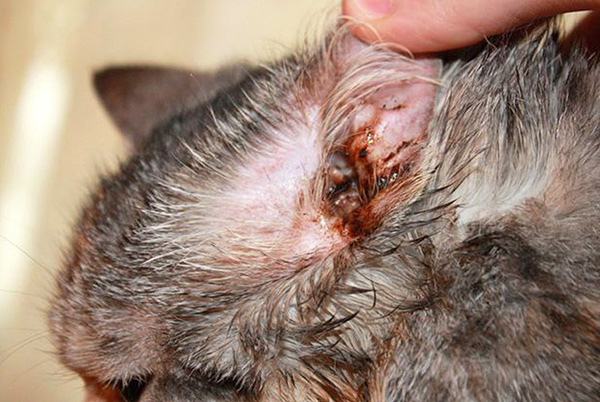
In addition, secondary symptoms are also observed, which manifest themselves in various forms - it can be an increase in body temperature, inflammatory processes, an increase in lymph nodes.
Here are the typical signs of an ear mite infestation in a cat:
- The animal becomes restless, often shakes its head;
- Sharply shakes off his ears and hits them with his paws, which often causes severe hematomas on the ears;
- The pet is not eating well;
- Little sleep;
- A brown viscous liquid or pasty mass is discharged from the ears, which smells bad;
- Kittens lag behind in growth and development;
- Sometimes hair may fall out near the ears;
- Pregnancy often exacerbates the disease, up to the appearance of convulsions and convulsions.
If you notice one or more of these symptoms in your pet, then you should contact your veterinarian. The diagnosis is made only after the selection of ear secretions and examination of them under a microscope. At high magnification, fast moving small arthropods will be clearly visible. Only after the diagnosis is confirmed, treatment is prescribed.
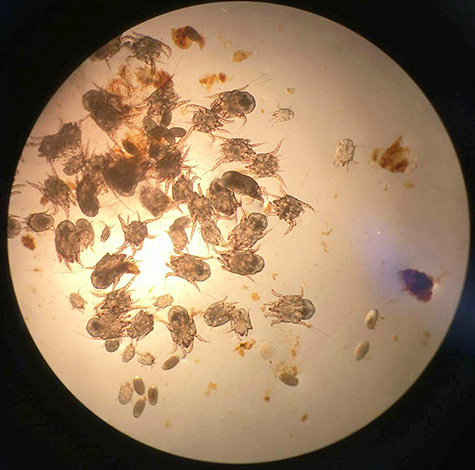
As noted above, unlike dogs, otodectosis in cats can often be latent or sporadic. Cats are more susceptible to the parasite than dogs, so inflammation in their ears starts faster and goes away more intensely.
Due to such an aggressive reaction of the body, the focus of tick parasitism in the ears subsides: several parasites remain in the ear canal, which multiply slowly and do not cause significant harm to the animal. This condition can last up to six months, until favorable conditions come for the tick population. Then the parasite will begin to rapidly increase in numbers, however, an intense immune reaction in the ears of the animal will again slow down the growth and development of the population.
Again, there will be a period of rest, in which the cat will only be the carrier of the parasite (the tick can be considered its commensal). In this period of time, nothing threatens the health of the cat, but it is a carrier of a parasite that infects other animals. The cat will spread parasites around the apartment - as a result can transmit ear mites to humans. It is because of this that it is very important to properly and regularly examine a pet, even if he seems to be in good health.
Sources of infection
Cats usually become infected through direct contact with animals with ear scabies. As noted earlier, the disease does not have a seasonal confinement, however, the peak of infection occurs in the summer-spring period, when pets actively go outside.
Touching and sniffing is enough for infection. In such a short period of time, a tick can move from a sick animal to a healthy one. Cats become infected during spring "marriage games", fights for territory, mating with sick females.

Kittens receive parasites from their mother during breastfeeding and grooming.
Most often, domestic cats are invaded by stray carnivores. In cats, the disease is highly contagious.
It is interesting
There is always a possibility of infection with ear mites through flies and fleas, which are not its specific carriers, but can mechanically bring the parasite from a sick animal to a healthy one.
Invasion also occurs through objects used by the cat (rugs, bowls, toys), as well as means of transportation (for example, cages). Sometimes parasites are carried on the clothes of a host who has been in contact with a sick animal.
How to get rid of the parasite
It is highly advisable to consult with your veterinarian before treating your cat for ear mites. The specialist, after appropriate tests, will confirm the diagnosis and prescribe a qualified treatment that can be done at home.Relying on folk remedies alone is not worth it, since their effectiveness is incomparably lower than the effectiveness of modern medications for otodectosis.
The first thing that is always directed at the treatment of otodectosis is the alleviation of the unpleasant symptoms associated with it. Initially, it is necessary to relieve inflammation and reduce itching, causing significant suffering to the pet. To do this, you need to clean the auricle from secretions.

Correct cleaning is carried out according to the following algorithm:
- We immobilize the cat and choose a comfortable position, as during the examination;
- Pour a softening agent into the sore ear - it is better to use a lotion to cleanse the ears (it is not recommended to use hydrogen peroxide for this purpose, as this can cause additional irritation and in rare cases create excessive pressure in the ear);
- We wait a couple of minutes and begin to gently massage the ear of the animal so that all the crusts and scabs move away from the skin (you can wipe the ears with two fingers, without pressing hard on the sink, so as not to hurt the cat);
- We remove excess liquid and soft mass with a cotton swab or disk (you should not use ear sticks - they still cannot clean all the mites from the ear, but it is quite possible to damage the eardrum).
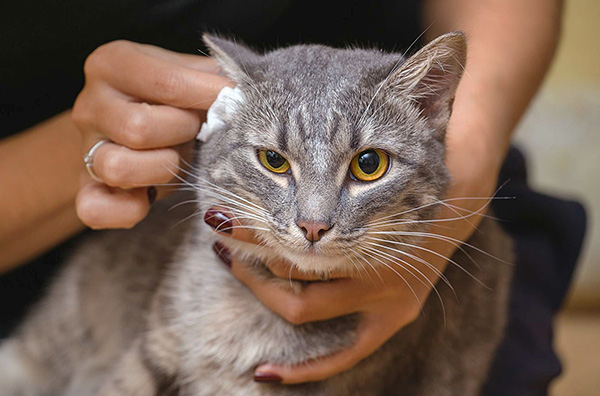
After such cleansing of the ear, you can proceed directly to drug treatment. If the ear canal is not cleaned first, then the medication may not reach the breeding site of the parasite due to the accumulated secretions, and the treatment will be ineffective.
Otodectosis can be cured with the help of various contact acaricides. They are available in the form of ointments, sprays, drops.
Treatment is carried out in strict accordance with the instructions for use for the selected agent. Often two treatments are enough with a frequency of 5-6 days.
On a note
Treatment of cats should be carried out carefully and not rush to stop it, since the ear mite can go through a dormant period. At the same time, the number of the parasite decreases to the absence of typical symptoms of otodectosis, but this does not mean that the parasite was finally removed. In order to completely rid the pet of parasites, several treatments of the ear canal may be required.
Preparations for the treatment of otodectosis in cats
To date, there are a large number of drugs aimed at combating otodectosis and other acarosis in pets.
Listed below are some of the best treatments for ear mange in cats that have proven themselves in practice and are time-tested:
- Aversectin ointment is a contact preparation that, in addition to the active substance (aversectin), also contains glycerin, which softens the skin and reduces itching. The ointment has a thick consistency and a specific smell, well envelops the skin, creates a protective film. With ear scabies, the ointment is placed in both ears after preliminary cleansing, then the auricle is massaged for better penetration of the drug. Use the medication strictly in accordance with the instructions. Depending on the intensity of the disease, the ointment is applied 2-5 times at weekly intervals. With a strong lesion, application every other day is acceptable. The drug is not recommended for use in debilitated and pregnant cats;

- Bars ear drops - according to numerous reviews, are considered one of the best drugs for combating otodectosis in cats (not to be confused with Bars drops against fleas and ticks, which are dripped on the withers). Contains components with antimicrobial and anti-inflammatory effects. 2-3 drops are introduced into the ear with a pipette (both ears need to be treated, even if only one is clearly affected);

- Amit are drops that are widely used to treat ear scabies in both cats and dogs. The drug is not absorbed into the blood, it acts locally in the breeding ground of parasites. It has anti-inflammatory properties and promotes rapid healing of tissues. The drug is applied 2-3 drops in each ear. There is a special contraindication - it is not recommended to use Amit as a prophylactic;

- Anandin plus - ear drops of contact action. The active substance immobilizes ticks, paralyzing them, and after a while the parasites die. The drug has immunomodulatory and anti-inflammatory properties. The drug is prescribed for both therapeutic and prophylactic purposes. Drops are injected into each ear, the procedure is repeated after a week.

These drugs are used for the local treatment of scabies localized in the ear canal. However, with a strong infection of the animal, ear mites can settle throughout the body and crumble in the apartment on carpets and furniture.
Especially a lot of ticks are found in the area of the pelvis and tail of the cat, which is explained by the habit of the animal to sleep in a “ball”. To cleanse the body of a pet from parasites, acaricidal shampoos and sprays are well suited. Treat all animals in the house to avoid further spread of ear mites.
How to avoid infection
The best defense against ear mites is prevention. First of all, it is necessary to limit the contacts of domestic animals with their stray relatives.
It is important to observe two basic rules of hygiene:
- Wash your cat regularly
- Examine the auricle 2 times a month in order to notice signs of infection in time and thereby prevent the development of serious consequences.
In addition to the pet’s personal hygiene, during an illness, it is necessary to carry out treatment in the apartment, since the ear mite disperses throughout the entire area of \u200b\u200bthe house and remains viable for up to a week.
What is important to know about ear mites in cats: comments from a veterinarian




